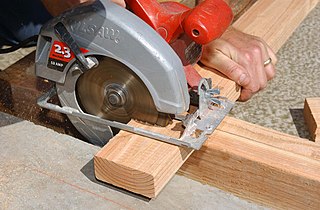
A circular saw is a power-saw using a toothed or abrasive disc or blade to cut different materials using a rotary motion spinning around an arbor. A hole saw and ring saw also use a rotary motion but are different from a circular saw. Circular saws may also be loosely used for the blade itself. Circular saws were invented in the late 18th century and were in common use in sawmills in the United States by the middle of the 19th century.

In woodworking and carpentry, hand saws, also known as "panel saws", are used to cut pieces of wood into different shapes. This is usually done in order to join the pieces together and carve a wooden object. They usually operate by having a series of sharp points of some substance that is harder than the wood being cut. The hand saw is a bit like a tenon saw, but with one flat, sharp edge.

Tongue and groove is a method of fitting similar objects together, edge to edge, used mainly with wood, in flooring, parquetry, panelling, and similar constructions. Tongue and groove joints allow two flat pieces to be joined strongly together to make a single flat surface. Before plywood became common, tongue and groove boards were also used for sheathing buildings and to construct concrete formwork.
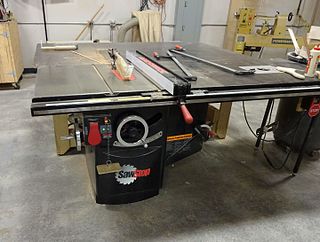
A table saw is a woodworking tool, consisting of a circular saw blade, mounted on an arbor, that is driven by an electric motor. The blade protrudes through the surface of a table, which provides support for the material, usually wood, being cut.

A bandsaw is a power saw with a long, sharp blade consisting of a continuous band of toothed metal stretched between two or more wheels to cut material. They are used principally in woodworking, metalworking, and lumbering, but may cut a variety of materials. Advantages include uniform cutting action as a result of an evenly distributed tooth load, and the ability to cut irregular or curved shapes like a jigsaw. The minimum radius of a curve is determined by the width of the band and its kerf. Most bandsaws have two wheels rotating in the same plane, one of which is powered, although some may have three or four to distribute the load. The blade itself can come in a variety of sizes and tooth pitches, which enables the machine to be highly versatile and able to cut a wide variety of materials including wood, metal and plastic.

A hacksaw is a fine-toothed saw, originally and mainly made for cutting metal. The equivalent saw for cutting wood is usually called bow saw.

A biscuit joiner is a woodworking tool used to join two pieces of wood together. A biscuit joiner uses a small circular saw blade to cut a crescent-shaped hole in the opposite edges of two pieces of wood or wood composite panels. An oval-shaped, highly dried and compressed wooden biscuit is covered with glue, or glue is applied in the slot. The biscuit is immediately placed in the slot, and the two boards are clamped together. The wet glue expands the biscuit, further improving the bond.

A flat or coulisse is a flat piece of theatrical scenery which is painted and positioned on stage so as to give the appearance of buildings or other background.
A miter saw is a saw used to make accurate crosscuts and miters in a workpiece by pulling a large backsaw or a mounted circular saw blade down onto a board in a quick motion. Miter saws are commonly referred to as drop saws and abrasive cut off saws are referred to as a chop saw.
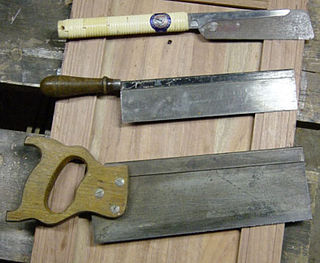
A backsaw is any hand saw which has a stiffening rib on the edge opposite the cutting edge, enabling better control and more precise cutting than with other types of saws. Backsaws are normally used in woodworking for precise work, such as cutting dovetails, mitres, or tenons in cabinetry and joinery. Because of the stiffening rib, backsaws are limited in the depth to which they can cut. Backsaws usually have relatively closely spaced teeth, often with little or no set.

A coping saw is a type of bow saw used to cut intricate external shapes and interior cut-outs in woodworking or carpentry. It is widely used to cut moldings to create coped rather than mitre joints. It is occasionally used to create fretwork though it is not able to match a fretsaw in intricacy of cut, particularly in thin materials. Coping saw blades are always thicker and much coarser cutting than typical fretsaw blades and many others of its family members. Coping saws can however cut slight bends in the work, allowing circles to be cut if used carefully.
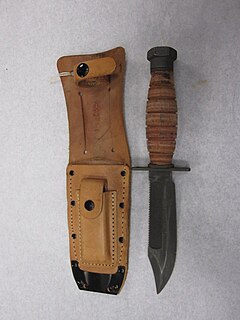
Survival knives are knives intended for survival purposes in a wilderness environment, often in an emergency when the user has lost most of his/her main equipment. Military units issue some type of survival knife to pilots in the event their plane may be shot down. Survival knives can be used for trapping, skinning, wood cutting, wood carving, and other uses. Hunters, hikers, and outdoor sport enthusiasts use survival knives. Some survival knives are heavy-bladed and thick. Other survival knives are lightweight or fold in order to save weight and bulk as part of a larger survival kit. Their functions often include serving as a hunting knife. Features, such as hollow handles that could be used as storage space for matches or similar small items, began gaining popularity in the 1980s. Custom or semi-custom makers such as Americans Jimmy Lile, Bo Randall, and Chris Reeve are often credited with inventing those features.

A scroll saw is a small electric or pedal-operated saw used to cut intricate curves in wood, metal, or other materials. The fineness of its blade allows it to cut more delicately than a power jigsaw, and more easily than a hand coping saw or fretsaw. Like those tools, it is capable of creating curves with edges, by pivoting its table.

In woodworking, veneer refers to thin slices of wood and sometimes bark, usually thinner than 3 mm, that typically are glued onto core panels to produce flat panels such as doors, tops and panels for cabinets, parquet floors and parts of furniture. They are also used in marquetry. Plywood consists of three or more layers of veneer. Normally, each is glued with its grain at right angles to adjacent layers for strength. Veneer beading is a thin layer of decorative edging placed around objects, such as jewelry boxes. Veneer is also used to replace decorative papers in Wood Veneer HPL. Veneer is also a type of manufactured board.
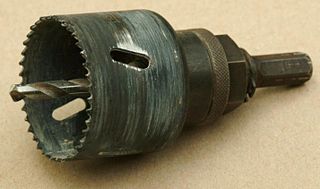
A hole saw, also known as a hole cutter, is a saw blade of annular (ring) shape, whose annular kerf creates a hole in the workpiece without having to cut up the core material. It is used in a drill. Hole saws typically have a pilot drill bit at their center to keep the saw teeth from walking. The fact that a hole saw creates the hole without needing to cut up the core often makes it preferable to twist drills or spade drills for relatively large holes. The same hole can be made faster and using less power.

The fretsaw is a bow saw used for intricate cutting work which often incorporates tight curves. Although the coping saw is often used for similar work, the fretsaw is capable of much tighter radii and more delicate work. It has a distinctive appearance due to the depth of its frame, which together with the relatively short five inch blade makes this tool appear somewhat out of proportion compared with most other saws.
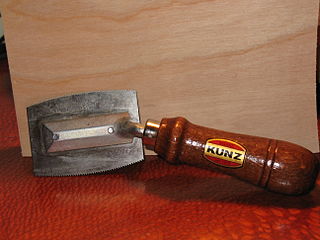
The veneer saw is a small double-edged tool for cutting thin hardwood veneer. Its narrow curved blade facilitates precision work, and its elevated offset handle makes it possible to cut flush with a surface. The blade is usually 3 or 4 inches long and it has 13 tpi.
A French flush-cut saw is a double-edged tool, similar to a veneer saw, that is designed for trimming the ends of dowels, tenons, and other protrusions flush with a surface. The blade usually has 11 teeth per inch on one side, and 20 teeth per inch on the other side, making it more versatile than other flush-cutting saws. The blade is approximately 6 inches long, and in order to avoid marring the surface, the saw teeth are angled slightly upward.

A compass saw is a type of saw used for making curved cuts known as compasses, particularly in confined spaces where a larger saw would not fit.

















